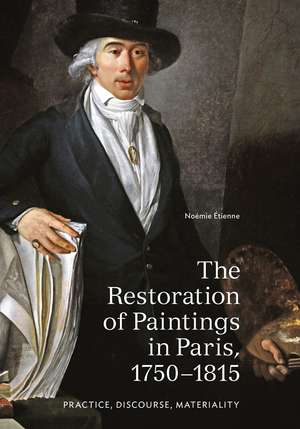The Restoration of Paintings in Paris, 1750-1815: Practice, Discourse, Materiality
Autor Noémie Étienneen Limba Engleză Paperback – 6 feb 2017
The decades following the 1973 publication of Alessandro Conti’s Storia del Restauro have seen considerable scholarly interest in the development of restoration in France in the second half of the eighteenth century. A number of technical treatises and biographies of restorers have offered insight into restoration practice. The Restoration of Paintings in Paris, 1750–1815, however, is the first book to situate this work within the broader historical and philosophical contexts of the time.
Drawing on previously unpublished primary material from archives in Paris, Berlin, Rome, and Venice, Noémie Étienne combines art history with anthropology and sociology to survey the waning decades of the Ancien Régime and early post– Revolution France. Initial chapters present the diversity of restoration practice, encompassing not only royal institutions and the Louvre museum but also private art dealers, artists, and craftsmen, and examine questions of trade secrecy and the changing role of the restorer. Following chapters address the influence of restoration and exhibition on the aesthetic understanding of paintings as material objects. The book closes with a discussion of the institutional and political uses of restoration, along with an art historical consideration of such key concepts as authenticity, originality, and stability of artworks, emphasizing the multilayered dimension of paintings by such important artists as Titian and Raphael. There is also a useful dictionary of the main restorers active in France between 1750 and 1815.
Drawing on previously unpublished primary material from archives in Paris, Berlin, Rome, and Venice, Noémie Étienne combines art history with anthropology and sociology to survey the waning decades of the Ancien Régime and early post– Revolution France. Initial chapters present the diversity of restoration practice, encompassing not only royal institutions and the Louvre museum but also private art dealers, artists, and craftsmen, and examine questions of trade secrecy and the changing role of the restorer. Following chapters address the influence of restoration and exhibition on the aesthetic understanding of paintings as material objects. The book closes with a discussion of the institutional and political uses of restoration, along with an art historical consideration of such key concepts as authenticity, originality, and stability of artworks, emphasizing the multilayered dimension of paintings by such important artists as Titian and Raphael. There is also a useful dictionary of the main restorers active in France between 1750 and 1815.
Preț: 383.68 lei
Preț vechi: 467.75 lei
-18% Nou
Puncte Express: 576
Preț estimativ în valută:
73.42€ • 76.50$ • 60.79£
73.42€ • 76.50$ • 60.79£
Carte indisponibilă temporar
Doresc să fiu notificat când acest titlu va fi disponibil:
Se trimite...
Preluare comenzi: 021 569.72.76
Specificații
ISBN-13: 9781606065167
ISBN-10: 1606065165
Pagini: 316
Ilustrații: 37 color and 33 b-w illustrations
Dimensiuni: 178 x 254 x 20 mm
Greutate: 0.98 kg
Ediția:1
Editura: Getty Publications
Colecția Getty Conservation Institute
ISBN-10: 1606065165
Pagini: 316
Ilustrații: 37 color and 33 b-w illustrations
Dimensiuni: 178 x 254 x 20 mm
Greutate: 0.98 kg
Ediția:1
Editura: Getty Publications
Colecția Getty Conservation Institute
Notă biografică
Noémie Étienne is currently a fellow at the Getty Research Institute. Beginning in September 2016 she will be Swiss National Science Foundation Professor of Art History at the University of Bern.
Recenzii
“Étienne impressively prompts revisions to pervasive conceptions in the literature and shapes novel interpretations.”
“Ambitious, meticulously documented. . . . The extensive bibliography and biographical directory of restorers will be invaluable resources for art historians and conservators.”
“One of the strengths of the book is that it raises more questions than it can answer. It should be a goldmine for future research. While highly specialized, it contains much that should be of interest not just to art historians, restorers, and conservationists, but also to historians, anthropologists, and all students of French culture in this period.”
